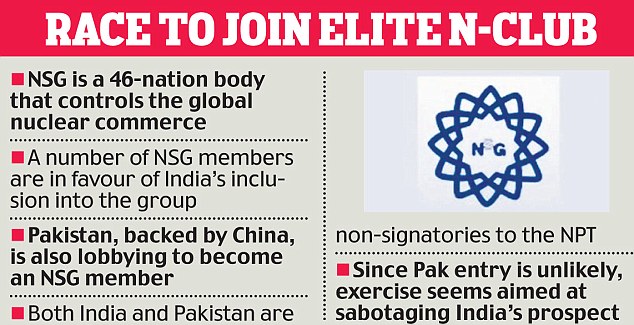
In the humdrum of a high-profile nuclear control body, Nuclear Suppliers Group (NSG), consideration of Indian membership to this group has caught everyone’s attention. I wonder how nations can forget the bitter past of Indian explosion in 70’s that lead to the birth of NSG. The question is that, why India being given a popular support from multiple countries for its membership in the NSG? Giving support to India also defines the clear picture of doublespeak.
Currently, India’s application is getting huge support for its membership in the NSG. In this context NSG members are reportedly discussing membership criteria for states not party to the Nuclear Nonproliferation Treaty (NPT). This will also include a requirement for clear and strict separation of current and future civilian nuclear facilities from non-civilian nuclear facilities.
NSG Guidelines excluded supply of nuclear material, items and technology to India for almost three decades because India has not completely accepted International Atomic Energy Agency (IAEA) Comprehensive safeguards. While examining one can clearly find out that there is nothing that meets the safety standards and agreement signed by India. Interestingly, the arrangements created by India are also in an unverified grey zone between military and civilian material. These arrangements are not satisfactory to substantiate that India is not using safeguarded material for military purposes.
To widen the discussion on this key issue, India in 2009 concluded safeguard agreement with IAEA and the agreement was a consequent of the Joint Statement of July 18, 2005 between Indian Prime Minister Manmohan Singh and United States President George W. Bush. In the statement given by India, India conveyed its readiness to assume the same responsibilities and practices as other leading countries with advanced nuclear technology and undertook inter alia:
· Will identify and separate civilian and military nuclear facilities and programs;
· Will place voluntarily its civilian nuclear facilities under IAEA safeguards.
Before signing the agreement in 2009 with IAEA, India had a number of “item-specific” safeguards agreements with the IAEA, based on the IAEA document INFCIRC/66. INFCIRC/66 model offers substantial flexibility of transferring nuclear material between safeguarded and unsafeguarded facilities. As a result of flexibility INFCIRC/66, there exist no separation plan between facilities designated as “civilian” and facilities serving military or strategic purposes. However, such flexibility is inappropriate to India’s current circumstances, where-in India has undertaken to separate civilian and military facilities and to place civilian facilities under safeguards.
Against this background, it appears India does not consider those facilities placed under safeguards to be relevant to the “strategic program”. Also the relationships between the civilian safeguarded, dual-use unsafeguarded, and military programs are opaque. The agreement should be amended to remove the provisions that can be harmful for future of the region. Also the continued operations of dual-purpose facilities in India is strategically provocative where India’s fast breeder reactors, and other unsafeguarded materials and facilities, serves as part of the military program, posing a strategic threat.
As India scale up its nuclear power program including its enrichment and reprocessing facilities, the existing mysterious overlap between civilian and military nuclear activities is likely to intensify in future that will have sever ramifications leading to strategic instability, increasing proliferation etc. Hence, India is, so far, the only country after the United States to have tested a nuclear device made of reactor-grade plutonium, which makes its unsafeguarded civilian nuclear facilities a source of concern for others. So the incompleteness of a verifiable separation of India’s civilian and military programs should be taken into consideration by nuclear suppliers before taking any decision for its NSG membership.
So keeping in mind the reality that India has not completely accepted IAEA comprehensive safeguards the deficiencies remain. A consensus should not be made to admit India as NSG member unless the Separation Plan and the agreement are amended. If this does not happen, it will have implications for South Asia and to non-proliferation regime as a whole.
Thanks to a series of nuclear cooperation agreements driven by the economic and commercial expediencies of great powers. The civilian nuclear program of India is expanding at a rapid pace. This substantial increment is constructing new pathways for India to further acquire fissile material, and it is happening at a time when India is still producing fissile material for nuclear weapons.
